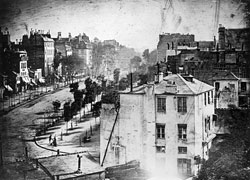The Invention of the Daguerreotype Process
 Boulevard du Temple, Paris, IIIe arrondissement, Daguerreotype. The image shows a busy street, but because exposure time was over ten minutes, the traffic was moving too much to appear.
Boulevard du Temple, Paris, IIIe arrondissement, Daguerreotype. The image shows a busy street, but because exposure time was over ten minutes, the traffic was moving too much to appear. Photograph scanned from The Photography Book, Phaidon Press, London, 1997. Courtesy of Michael Maggs, Wikipedia
The invention of Daguerreotype, an image captured in copper, marked the metal's first milestone in the field of photography.
French artist Louis Jacques Mande Daguerre first began tinkering with a camera in 1824 and was successfully taking positive images via his namesake Daguerreotype method by 1837. In 1829, he had teamed up with French scientist Joseph Nicephore Niepce, who discovered how to produce a photographic image using a camera, silver-plated sheets of copper and silver iodide.
The only drawback was a lengthy eight-hour exposure time.
Through further experiments, however, Daguerre learned that implementing mercury vapor during development could reduce exposure time to about 30 minutes. He also perfected the process with a hyposulphate of soda fixing agent.
By 1839, the Daguerreotype was officially introduced to the paying public. Portrait studios began popping up in Paris, which opened about a dozen by 1844, and New York, boasting more than 70 by 1850. English chemist John Frederick Goddard, who fine-tuned the exposure time, was instrumental in the influx of these studios. He partnered with Richard Beard to open London's first studio on Regent Street in 1841.
The detailed, step-by-step Daguerreotype procedure of that time began with polishing and buffing the silver-coated copper with a soft cloth, powder and oil until the silver plate was glossy like a mirror. The prepared plate was then sensitized in an airtight iodizing box, where it was first exposed to iodide vapor, turning it orange, and face-down exposed to chloride of bromine fumes. The combination of the chemicals resulted in the necessary light-sensitive coating.
The plate was loaded inside the camera and, after the photographer posed the subject with head rests, clamps or stands, an exposure was made on the plate surface by removing the lens. Exposure times improved from 30 minutes in 1839 to less than a minute by 1842. Developing of the image was done in the dark, hanging over a dish of heated (60 degrees) mercury.
Any unexposed silver iodide was washed off the plate with a sodium chloride solution to delicately "fix" the mercury highlights and shadows of the image. Because the photo was so delicate, the plated image was made less fragile when heated with gold chloride.
Some portraits were hand-colored, after the plate was coated in gum arabic and dried. The artist would breathe on the plate to create a sticky surface and use a paintbrush and dry powder pigment. Mounting of the Daguerreotype was protected by a glass-fronted frame to resist any scratching.
Although fewer people practice this today due to the lengthy process, a recent revival is helping put the focus back on Daguerreotype in the broader art world.
Also in this Issue:
- The Metal Museum: Providing the Tools for a New Generation of Coppersmiths
- The Invention of the Daguerreotype Process
- Picture it Perfect: Kinetic Copper Sprinklers
- Susan Venable Studio: Ancient to Abstract Constructions
- Arline Fisch: Creatures from the Deep
